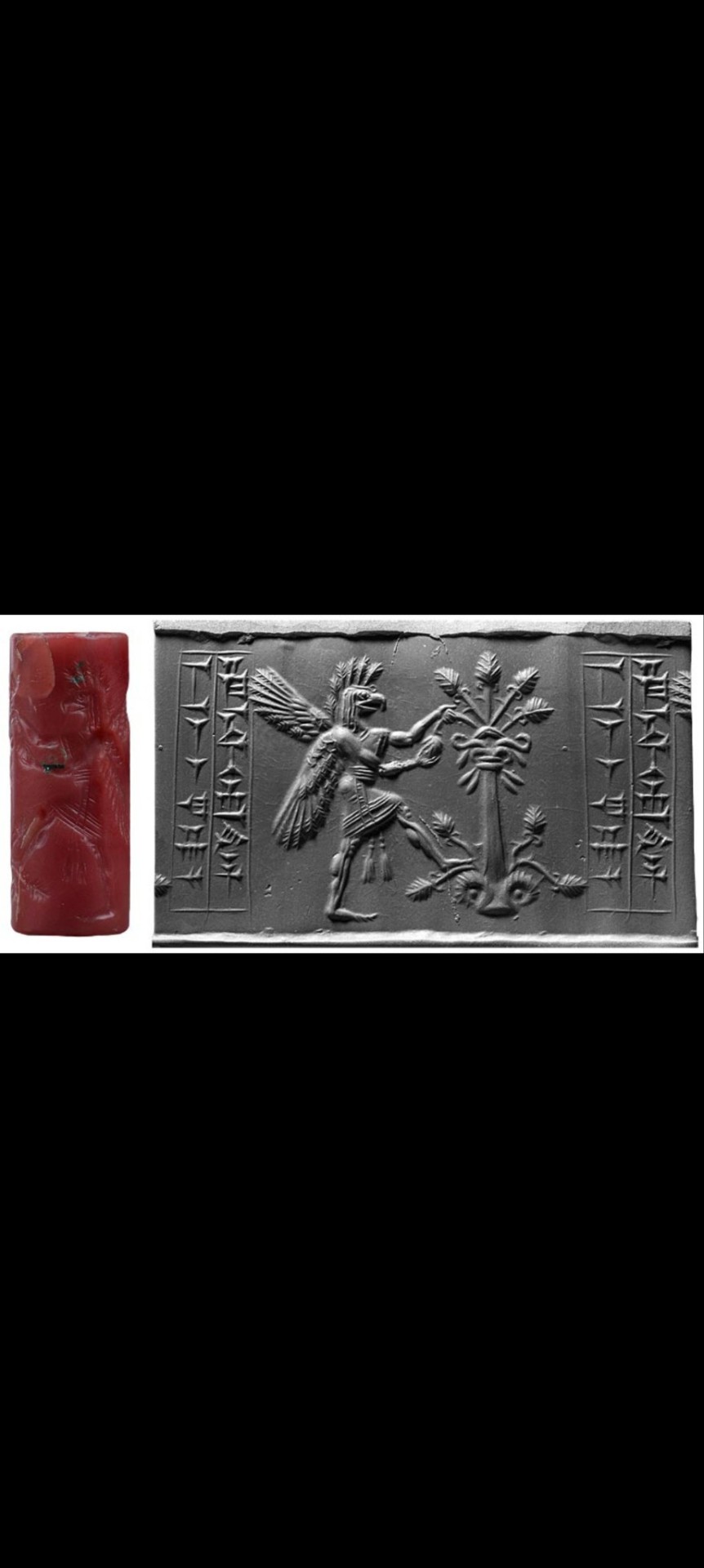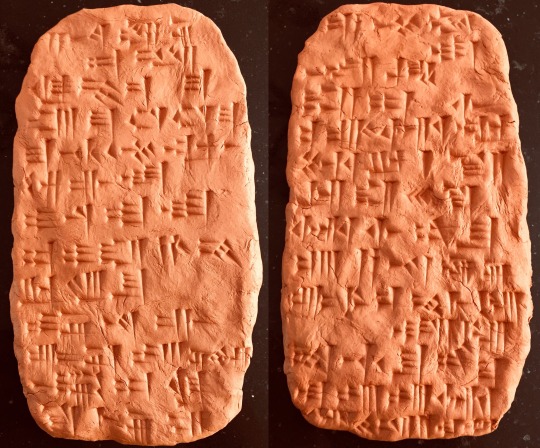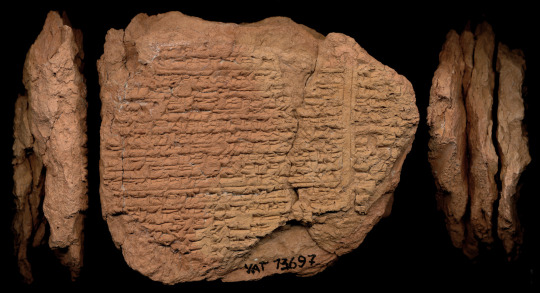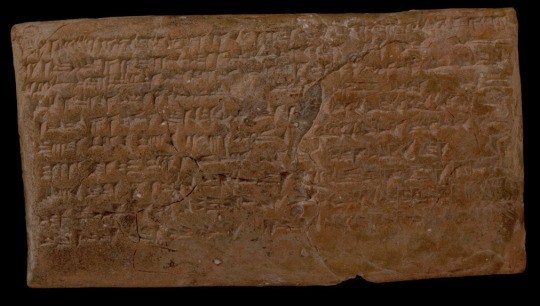Text
I don’t post here much lately because I’m busy, well, doing actual Academic Writing. But I thought y’all might enjoy this piece that I wrote about Purim and Esther/Ishtar and reading the Bible as fan fiction. (This is what my next book is going to be about.)
Happy Purim to all who celebrate!
124 notes
·
View notes
Text
Coriander and Clay: A Sapphic Cottagecore Romance
Blake has spent her career translating cuneiform tablets, but this one is different: an ancient collection of recipes. To decode them, she turns to a local chef whose prickly demeanor conceals her painful history. Side by side, they spend a summer experimenting with flavors of the past—and sizzling chemistry in the present. But when the tablet reveals a secret that could transform the world of Assyriology, will the bond they've built withstand the fallout?
Chasing trends...
"... and as that’s happening, BookTok is going to be like, “Hey, you know what’s hot now? Cottagecore Mesopotamian Cookbook Fiction.” Which isn’t a thing yet, but who the fuck knows? It sounds great, whatever it is. We get Big Feels and Earnest Confessions and Weird Ancient Soups!"
As someone who has, in various contexts, written a) cottagecore, b) foodie romance, and c) Mesopotamian fiction, I feel like this is a trend that I should leap onto.
You'd read it, right?
113 notes
·
View notes
Text
Chasing trends...
"... and as that’s happening, BookTok is going to be like, “Hey, you know what’s hot now? Cottagecore Mesopotamian Cookbook Fiction.” Which isn’t a thing yet, but who the fuck knows? It sounds great, whatever it is. We get Big Feels and Earnest Confessions and Weird Ancient Soups!"
As someone who has, in various contexts, written a) cottagecore, b) foodie romance, and c) Mesopotamian fiction, I feel like this is a trend that I should leap onto.
You'd read it, right?
113 notes
·
View notes
Note
Hey! How are you? I hope you're doing great!
May I have a translation from these cuneiform writings? :) I'm dying to know what it's written there. I'm trying to make out a few things here and there, but it's quite puzzling to fathom, to say the least. Anyhow, if you're able to do it, I'll be more than appreciative and thankful for it. Thank you


What beautiful seals! It looks like you've come across Morgan Seal 747 and Morgan Seal 609. (Click through for more discussion.) A full write-up of the seals, including their inscriptions, is in CANES 1 by Edith Porada, which unfortunately I don't have access to. Aruz et al also talk about the first seal in Assyria to Iberia at the Dawn of the Classical Age.
The inscriptions appear to be identifying the owners of the seal. The first seal is inscribed (according to Aruz et al) with "[belonging] to Nabu-nadin-shumi son of Ashur … may [the god] Nabu grant [him] life!" The second seal mentions a man named Ashur-iddin.
I hope you'll forgive me leaving things there. It's the start of my first semester as a professor, I don't have CANES to reference, and my cuneiform-reading skills are rusty. Anyone else want to jump in?
92 notes
·
View notes
Text
Thanks!! It's so fun to see that this is making the rounds again in the wake of Season Two.
The names are made up, but the etymologies are real. That's why I made comments about how the names were "rare," because they aren't actually attested for real Mesopotamians. They just come from real Akkadian roots.
A Letter from “Crawly” to Azirapil

This remarkable letter of unknown provenance surfaced recently in the cuneiform collection of the University of West Wessex. Addressed to Azirapil from a Mr. “Crawly,” it appears to be begging for the other’s return to Ur from a western journey with another individual, Abiraham. The relationship between the two (brothers? business partners? friends?) is unknown, and all three names are quite unusual. The letter also mentions a Mr. Ea-naṣir in Ur; if this is the same Ea-naṣir as the merchant mentioned in UET V 22, 29, 71, and 81, then the original letter would be dated to the Larsa period, around 1800 BCE. However, this particular copy appears to be a scribal exercise; the writing is relatively unskilled, and the cuneiform is Neo-Assyrian in form. It is unclear whether the text is based on a historical letter, or if its unusual names and content were invented for scribal practice.
Text:
Tell Azirapil [1]:
Thus says “Crawly” [2]:
When will your time in the West be finished? Abiraham [3] seems very dirty, and I am weary [4] in Ur. [There is] a talented mirsu-maker [5] on Wide Street!
Watch out, for I have acquired a new friend. His name is Ea-Naṣir [6], and I may play wickedly with him if you do not return.
Come quickly!
Keep reading
30K notes
·
View notes
Text
Mostly this post is an excuse to show off my new check mark, because of COURSE I had to get it.
But I suppose I should announce that my sporadic posts are about to get even more sporadic, for a very good reason: I will be starting next month as a tenure-track professor of Hebrew Bible!
I still would not recommend going into ancient languages as a career; there are far far fewer jobs than there are brilliant people who want them. But somehow, miraculously, I managed to win one of the few ones out there. I feel absurdly lucky.
(And of course I also feel grateful to everyone who has interacted with my posts here; this blog made a huge difference in helping me to feel part of a community of ancient nerds! Love you all.)
165 notes
·
View notes
Note
Hello! What text is TCL 6 49 r.13-29 (referring to Lamashtu) referring to specifically? Thank you :)
"TCL" stands for "Textes cunéiformes du Louvre," "6" means that it's from the 6th volume of publications of those texts, and "49" means that it's the 49th text in that volume.
You can learn more about the text on its CDLI page here or its Louvre page here. Let me know if you need any further information!
(For reference, my translation is here.)
27 notes
·
View notes
Text
Good question!
The short answer is: it didn't. Shamash as the word for the sun/Sun-god is well-attested in almost every Semitic language. It's in Hebrew, too: shemesh means "sun."
But shamash, meaning "helper"—specifically used for the ninth "helper candle" in a Hanukkah menorah—is a much later development. It comes from the verb shamash, which first appears in post-biblical Hebrew, like the Mishnah and Talmud. According to Jastrow (and it seems reasonable to me), shamash is a shin-stem of the older Hebrew verb mashash, which means "to touch or handle." Since Semitic shin-stem verbs are generally causative, shamash would therefore mean "to cause to handle, i.e. to minister or officiate." From there, it became the noun shamash: "one who ministers or attends to someone." It probably wasn't used in the context of a candle until the 16th century.
So in this case, the two words converged from different directions. Both are spelled the same in consonantal Hebrew—שׁמשׁ—but they originally derive from different roots.
(And why is it pronounced shemesh instead of shamash in Hebrew? Because it's a segolate noun, a noun that once ended in a double-consonant cluster, and Hebrew gives those e-sounds to make them easier to pronounce.)
An Incantation Against Depression (VAT 13697)

This is an excerpt from a lengthy Akkadian ritual that we know from multiple tablets, all of them unfortunately broken. The ritual starts by describing the patient: he is constantly depressed and has other physical symptoms, from pain to nausea. Such symptoms are clearly a sign that he has been attacked by witchcraft. To combat the witchcraft, the ritual practitioner relies on a combination of magical actions (such as burning figurines of the magicians who caused the illness) and prayers to Shamash, the Sun-god, who represents an all-seeing force of justice.
This is the first of the incantations recited by the practitioner. Below the cut, I’ve included the transliteration of the incantation (in case anyone wants to try it) and a short comment on the untranslated word “Namraṣit.”
I call to you, Shamash. Listen to me!
Accept my sleepless sighing.
Learn swiftly of the suffering that seizes me.
I am sluggish; I am sleepless; I am exhausted; I am anxious.
I focus on Namraṣit, your light, o my lord.
Shamash, lord of justice, to you I turn.
Pay attention to my lifted hands; listen to my speech.
Listen to me; accept my petition;
judge my case; decide my verdict.
Keep reading
781 notes
·
View notes
Note
I saw your blog and I think you might be able to help with something I've been failing to get anywhere with for a while! I'd like to get a tattoo of a line from one of Enheduana's hymns to Inana, but while I've managed to find translation, transliteration and references, I don't have the research chops to find the original cuneiform, which is what I really want.
The one I'm after is translated as "To rove around, to rush, to rise up, to fall down and to ...... a companion are yours, Inana." (Line 116 of 'A hymn to Inana (Inana C)') in the Electronic Text Corpus of Sumerian Literature.
Any chance you could hook me up?
Here's what I've got.
The tricky thing here is that the "original cuneiform" is dense and written in 3D, which makes it difficult to duplicate in a tattoo if you're just operating off a photo. But you can find photos of this text on the CDLI here, if you scroll down, to give you a sense of the problem.
A simpler route is to "cuneify" the values of the cuneiform symbols, i.e. to convert them into standardized Unicode symbols. Those will be much easier to copy. This is, I think, the line you want, in syllabic cuneiform:
𒌨 𒊒 𒌨 𒌌 𒇻 𒌌 𒍣 𒄑 𒍣 𒄖 𒊒 𒄭 𒀭 𒋫 𒋛 𒋛 𒋼 𒀭 𒈹 𒍝 𒀀 𒄰
(You'll need to install a cuneiform font for it to display right.)
All that said, for something to be tattooed permanently on your body, you want to be certain it's correct—and at the end of the day, I only have expertise in Akkadian, not Sumerian. (They're completely different languages that share a cuneiform writing system.) I would highly advise checking with @sumerianlanguage or another Sumerologist before you get anything inked.
40 notes
·
View notes
Note
Hello, I come to you for assistance with the Ea-nāṣir investigation. A Reddit post by u/artificial_scarcity has alerted us to the existence of another letter to Ea-nāṣir, held by the British Museum, whose translation appears to be heretofore unavailable online. Its listing on the museum's online catalog is 131221. Given your previous work on the cuneiform complaint copper caper case, I thought I should come to you to help with the search for a translation of this tablet.
Hello! This tablet (whose image is here) does have an online translation here on Archibab. An alternate translation is in Leeman's book.
More copper shenanigans...
124 notes
·
View notes
Text
Several months ago, I got a message asking for the cuneiform for Ea-nāṣir’s name, which I provided. I was utterly delighted to receive these in the mail!
Get your own fabulous keychain at this link.

5K notes
·
View notes
Note
Hi! I’ve been trying to learn more about the Hittite Kikkuli texts (especially CTH 284). Do you know if they’ve ever been fully translated into English? If they have, do you know where I can find this translation?
I’ve been looking online but I haven’t been able to find anything so far. I was hoping you, as the dead languages blog, might have some insight, or have some idea for where I could look next. Thanks!
Hi there! I have unfortunate news for you: as far as I can tell, there is no English translation of the full text, and it is not available on hittitetexts.com or CDLI. For the full translated text, you can look at Hippologia Hethitica (Kammenhuber, German) or L'Art de soigner et d'entraîner les chevaux (Masson, French)—neither of which is online either.
As you probably already know, Dent (The Horse Through Fifty Centuries of Civilization) made an English translation of part of the text, but only part, available here.
So I'm afraid that your next step is to ask your library for ILL copies of Kammenhuber and/or Masson, then use Google Translate or a multilingual friend. Good luck!
29 notes
·
View notes
Note
I need a hymn of isis pls
Sorry, Egyptology is not my specialty! But this paper contains two hymns to Isis, in both transliteration and translation, so hopefully it'll help: Two Hymns to Isis from Philae Revisited.
274 notes
·
View notes
Note
Thanks for the tag!
The phrases you cite are originally from the Udug-hul Incantations; the text that @sumerianlanguage links is a commentary on those incantations that happens to quote those specific lines. Fortunately, those incantations are discussed in an open-access (i.e. free!) text that you can download here. The second quotation is on page 135, from line 4 of Tablet 4 (contra this discussion), though its spelling matches the commentary rather than any extant copy of the incantation.
The first quotation is from the commentary, and it literally says “From within [the text] ‘Be Released, Evil!’” The part that means “be released, evil” is simply “puṭur lemnu,” and it’s from the first line of Tablet 2 of the Incantations, which makes it the “title” of that tablet.
As for the cuneiform, the Unicode is as follows (you’ll need to download a cuneiform font to display it):
ina a-ra-al-le-e še-pa i-šak-nu: 𒀸 𒀀 𒊏 𒀠 𒇷 𒂊 𒊺 𒉺 𒄿 𒊕 𒉡
pu-ṭur lem-nu: 𒁍 𒌉 𒅆 𒉡
Incidentally, “Arallû” is a name for the Netherworld, but it’s not the most common one; much more common is erṣetum, which also means “earth.”
As for your final question, could you clarify: do you mean “invite evil in” as an imperative (“You, invite evil in!”) or an abstract phrase (“to invite evil in”) or something else? If you could explain the context, I can provide a translation.
So I came across some Sumerian on a Yale website while doing some research and I was trying to figure out what the cuneiform for the phrase ina ŠÀ pu-tur lem-nu was and also for ima a-ra-al-le-e še-pa i-šak-mu. I think it was saying the first one meant "Be released, evil" and the 2nd meant "They set their feet into the netherworld" but I was wanting to double check. On a separate note what would the way to say "invite evil in". Working on this for a short story so any help would be appreciated.
Hello! I believe the phrases you’re looking for are both in Akkadian, not in Sumerian. They are from this text, whose first line is in Sumerian but the rest, including ina sha puṭur lemnu “Be released, evil” and ina araallee shepa ishaknu maa sha daaki shuu “They set their feet into the netherworld”, are both in Akkadian. Unfortunately, my knowledge of Akkadian cuneiform is rough enough that I don’t think I can attempt to hunt down all of the signs and guarantee an accurate answer. There is a page on the source tablet with images, which may act as a start, but if anyone out there with a stronger knowledge of Akkadian cuneiform can help out, I’d appreciate it!
74 notes
·
View notes
Text
“You shit bucket of a farter!” (SAA 3 30)

This ancient Neo-Assyrian "diss track," framed as a magical incantation, offers a series of slurs (some misogynistic and homophobic) against a Mr. Bel-eţir. It seems to conclude with an aggressive invitation: “fight me!”
There are multiple Bel-eṭirs in the historical record, but this is probably the same son of Ibâ who had a satire of a birth-legend written about him.
Although the tablet is well-preserved, many of the phrases are obscure; I have used italics to indicate where I am less certain of my translation.
...
Incantation:
Mr. Bel-eṭir, you twofold prison fucktoy, twofold soggy, twofold staring, son of Ibâ, absent epoch, shit bucket of a farter, second-rate clan, slave of a dead god, house whose star has vanished from the sky, maidservant, woman, slave of Lady Balihitu, beard among fucked-out women, "Mr. Baby-boy," much-maligned man.
Mr. Ammanappu provided your whitewash, saying: "First of all, his house is in shadow, starting at the top." He swore by the Lord, "I will not let go until I have fucked him!"
Let go of what Mr. Ammanappu has! Don't chase after what Mr. Tamru has! Stay away from Mr. Ammanipite! Keep your crotch away from Mr. Haimbi!
Now I have spoken to you. On account of this, rise up against me!
4K notes
·
View notes
Note
Howdy! I've just found your blog and will have fun poking through the archives. I've just begun studying Akkadian--because of course it makes sense to start such a thing on my own at age 59! I've got a copy of A Grammar of Akkadian and the answer key. That's a good place to start? Is there a resource for if I do not understand why an answer in the key is correct? E.g., Answer G8 in the exercises for lesson two--why is "wool" in the genitive and not the nominative? I'm so confused...
Hi there, and welcome to the world of Akkadian.
Huehnergard's Grammar is a very solid place to start, but some folks find it too comprehensive, since it's trying to be both a teaching guide and a full grammar. If you're enjoying it, great; if you're struggling, you can try Caplice's Introduction to Akkadian, which is a little more bite-sized.
As for question 2.G.8 in Huehnergard, I stared at the question for a long time, double checked the most recent versions of his answer key, and finally asked a friend who's a professional Assyriologist (I'm more of a dabbler). We agree that it's an error in the answer key; "wool" should definitely be nominative.
Good luck on your Akkadian adventure!
65 notes
·
View notes
Text
@lady-inkyrius asked how Ea-Naṣir’s name is actually pronounced. I'm pretty terrible at IPA, but his name is spelled "Ea-Nāṣir" with a dot under the s, which is a "ts" sound. The vowels approximately rhyme with "say-the what-here."
Ea-Naṣir Goes Clothes Shopping (UET V 848/BM 131428)

In the interest of helping y’all stalk a guy who’s been dead for three thousand years, I present to you another document excavated from the archives of Ea-Naṣir! This one is a purely practical one: a record of sale for 50 garments to Ea-Naṣir. The guy apparently liked his clothing (or, more likely, bought it to sell as a merchant).
11 garments:
value: 1/3 mina, 2 2/3 shekels of silver
5 garments:
value: 13 shekels of silver
2 garments:
value: 6 ½ shekels of silver
5 garments:
value: 10 2/3 shekels of silver
27 garments:
value: 5/6 mina, 4 ½ shekels, 15 še
______________
50 garments:
value: 1 2/3 mina, 7 1/3 shekels, 15 še:
in the hands of Mr. Ea-Naṣir
(A mina was about 500g; a shekel was 8.3g; a še was .05g. So the total weight in silver for 50 outfits was about 895g, or two pounds.)
19K notes
·
View notes